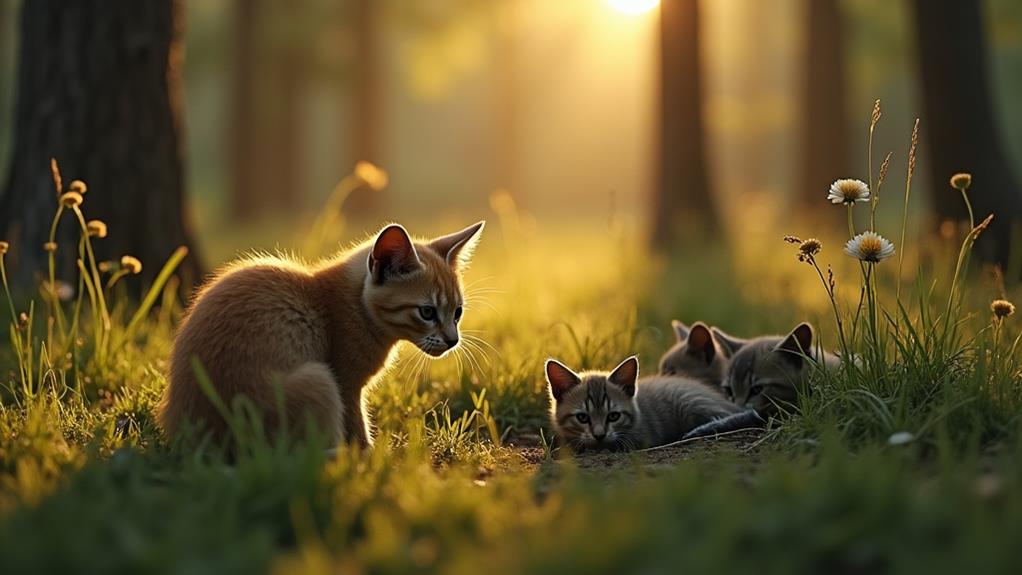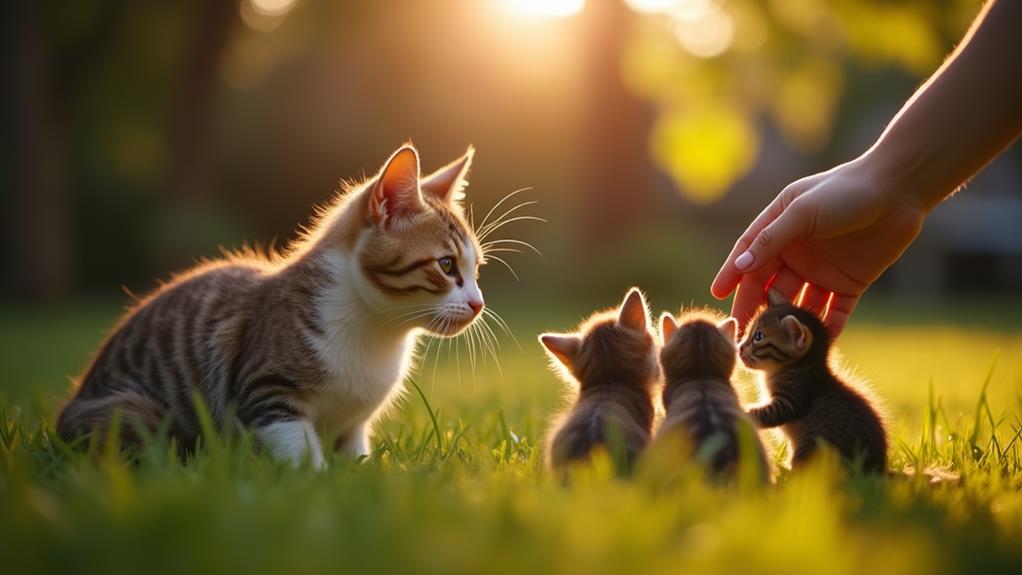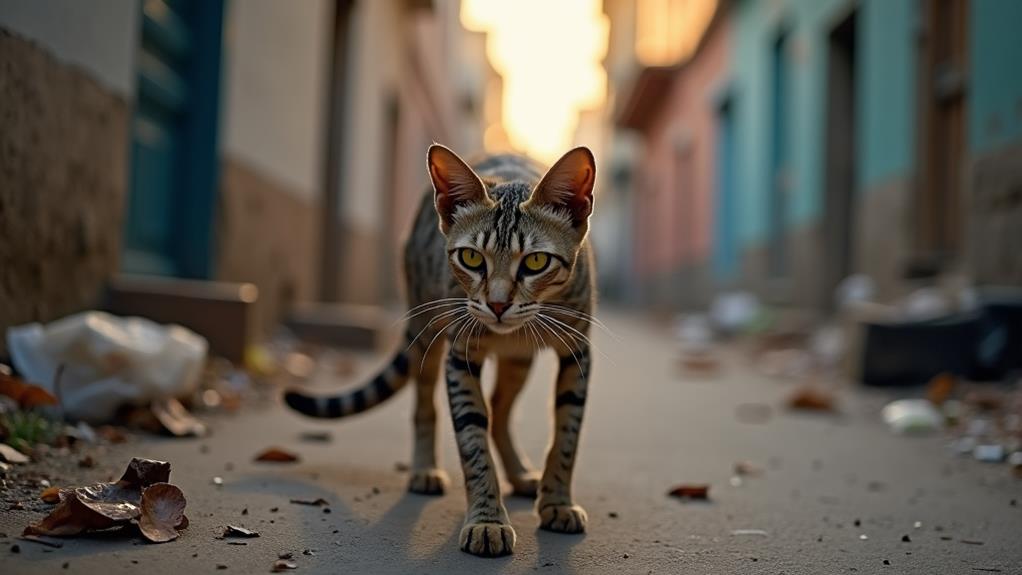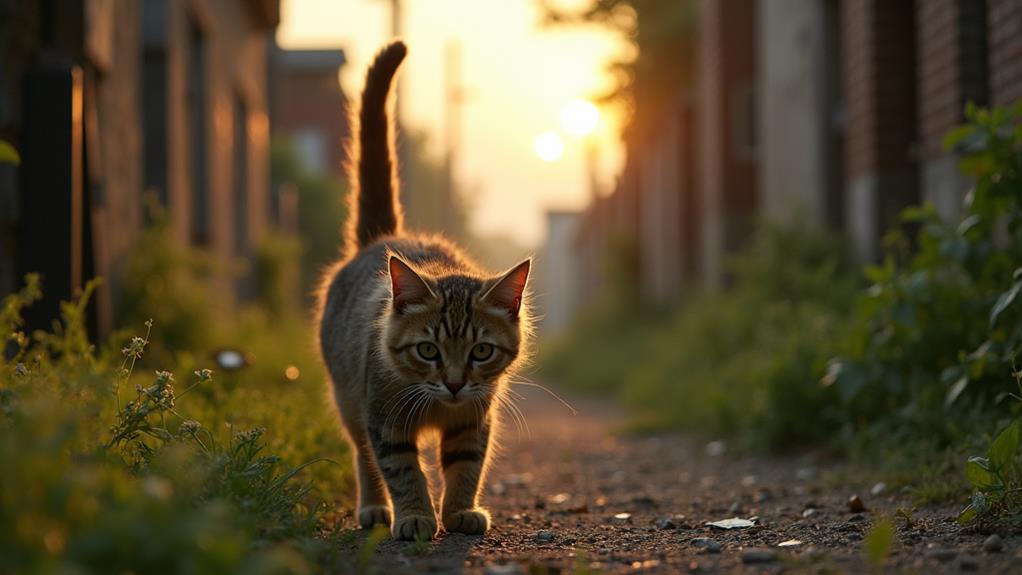How Long Will a Feral Cat Leave Her Kittens? What to Expect

Feral cats usually leave their kittens for short periods, typically 30 minutes to a few hours, to hunt or check for dangers. During the kittens' initial two weeks, the mother stays nearby since the kittens are very dependent on her for warmth and milk. If a mother is absent for more than six hours, it might mean she's abandoned them, and you should look for signs like constant crying or neglected fur. Intervening becomes critical to guarantee the kittens' survival and proper development. Uncover what steps to take if you notice prolonged absences and how to care for motherless kittens effectively.
Understanding Feral Cat Behavior
Understanding feral cat behavior starts with recognizing their instinctual nature. Feral mother cats are driven by survival instincts, balancing the need to protect and feed their young kittens. As a nursing female, a mother cat's primary role is to guarantee her kittens receive the nutrition and care they need, especially during their initial week of life when they are most vulnerable. You'll notice that during this pivotal period, the mother rarely leaves their side, staying close to provide vital nursing and protection.
However, as the kittens grow, the mother cat will start to leave the nest for short periods, usually just a few hours. During these times, she hunts for food or assesses potential dangers in the environment. Her instincts guide her back to the nest, assuring her kittens remain safe and nourished. But be aware, if food becomes scarce, a feral cat may abandon her kittens around eight weeks old, increasing their risks without her maternal care.
Maternal behaviors like grooming and feeding play a significant role in the health and social development of young kittens. These behaviors are fundamental for their survival and future independence in the wild.
Early Nursing and Care
Recognizing the instinctual behaviors of feral mother cats helps you appreciate the significance of early nursing and care for their kittens. During their initial critical weeks, feral kittens depend entirely on their mother cat for survival. She rarely strays far, ensuring they receive fundamental nutrition and care through nursing. Her milk provides everything the kittens need, including essential antibodies to bolster their immunity.
Feral cats are attentive mothers, and although they may leave their kittens briefly, their absence is never long. The mother cat might venture out to hunt or check for threats, but she quickly returns to resume her nursing duties. This period is crucial, as it lays the groundwork for the kittens' development.
In these early weeks, kittens learn social skills from their mother and siblings, which are significant for their well-being. The mother cat's care fosters a safe environment where they can grow and thrive. Her role is critical, not just for nourishment but also for teaching them how to interact with their surroundings.
Here's a quick look at the fundamentals:
- Nursing provides essential nutrition and immunity.
- Mother cats briefly leave for necessities.
- Early weeks are crucial for social skills.
- Solid food is introduced around 3-5 weeks.
- Feral cats offer attentive, dedicated care.
Kittens' Developmental Milestones

As feral kittens grow, they hit several significant developmental milestones that shape their future. During the initial two weeks of development, kittens need constant care from Mama Cats as they're completely reliant on them for nursing. With their eyes closed and inability to walk, they depend on their mother for warmth and food. Around the two-week mark, kittens begin to open their eyes and start hearing, marking a shift into a more interactive stage.
Maternal Absence Periods
Mother cats often leave their kittens for short periods, usually ranging from 30 minutes to a few hours, to hunt for food or scout for potential dangers. During these times, maternal absence is a normal part of a feral cat's routine. While the mother is away, the kittens are left vulnerable but she usually returns to nurse and care for them. It is vital to understand that these absences are necessary for the survival of both the mother and her kittens.
Consider the following:
- Duration: Absences typically last from half an hour to a few hours.
- Purpose: The mother leaves to find food or check for threats.
- Impact on Kittens: They rely on her return for nursing and warmth.
- Age Factor: Older kittens, nearing weaning period (around 6-8 weeks), may experience longer maternal absences.
- Environmental Safety: It is important to guarantee the kittens' environment is safe during these periods.
As a caretaker, you must monitor the kittens' health and surroundings while the mother is away. Prolonged or repeated absences without her return can increase risks, so observing her patterns and guaranteeing a safe environment is key to their well-being.
Signs of Abandoned Kittens

Spotting signs of abandoned kittens is fundamental for their survival. If a feral cat mother hasn't returned to her kittens for more than six hours, especially when they're under four weeks old, you may be dealing with abandoned kittens. During these significant early weeks, constant nursing is imperative for their growth and health. Without the mother cat's presence, the kittens might be in immediate danger, needing urgent attention.
Observe the health of the kittens closely. Healthy kittens can endure a few hours without food, but watch for persistent crying or unusual lethargy—these are red flags indicating potential abandonment. Also, check their fur condition and cleanliness; neglected appearances can signal the mother cat's prolonged absence. If the kittens lack warmth or are found in exposed, unsafe locations, it's a clear sign they need help.
Consistent absence of the mother cat during this important nursing period further suggests abandonment. In such cases, taking quick action becomes paramount. By recognizing these signs, you can determine if intervention is necessary to guarantee the kittens' well-being and survival. Understanding these cues can make all the difference for these vulnerable young lives.
Intervening With Motherless Kittens
Finding motherless kittens can be challenging, but your intervention might be their only chance for survival. Initially, observe the situation—sometimes a mother cat will leave the kittens alone for several hours while searching for food. Before taking action, it's essential to assess the health of the kittens. Look for signs like clean fur, bright eyes, and if they are quietly sleeping or crying for prolonged periods.
If the mother cat doesn't return after some time, and the kittens appear in danger or very sick, it's time to step in. Here's what you should do:
- Assess the health: Check the kittens' appearance and behavior; immediate action is needed if they seem unwell.
- Warmth: Keep them warm, as kittens can't regulate their body temperature well.
- Nutrition: Use Kitten Replacement Milk (KMR) for bottle-feeding if they're under five weeks old.
- Leave the kittens alone unless they're in danger, as premature separation can be harmful.
- Veterinary care: Seek professional help for a thorough health check-up and guidance.
These steps will help guarantee the kittens have a fighting chance at survival until they can be socialized and adopted.
Socialization and Adoption Timing

Successfully raising well-adjusted kittens hinges on understanding the importance of socialization and timing their adoption appropriately. Kittens need to stay with their mother until they're at least 12-16 weeks old. This period is vital for developing fundamental social skills and health. During this time, they learn from their mother and littermates, which helps them become more confident and socially adept.
Starting socialization around 5-6 weeks is key. Introduce them to different people and gentle handling to reduce timid behavior later on. Though kittens can be adopted as early as 8 weeks, waiting until they're 12 weeks old is better for their behavioral development and comprehensive health. This guarantees they've had enough nursing time and are well-equipped with social skills and litter box training.
Before considering adoption, observe their interactions with their littermates and mother. This gives you insight into their readiness for new environments. Ultimately, confirm they're spayed or neutered before rehoming to prevent future feral cat populations. Prioritize the developmental needs of the kittens to verify they've mastered social dynamics and basic survival skills. This thoughtful timing supports their shift into loving homes.
Resources for Feral Kittens
Understanding the importance of socialization and adoption timing prepares you for the next step: accessing resources for feral kittens. These resources are crucial in ensuring the kittens receive the care they need to thrive and seamlessly shift into domestic life. Local organizations and community outreach programs are invaluable for providing guidance and materials. For instance, groups like the East Bay SPCA offer resources focused on the care and socialization of feral kittens, enhancing their adoption prospects.
Here are some key resources and strategies to take into account:
- Pet Food Express: They offer free starter kits that include necessities for raising kittens. These kits can be a great help for new caregivers.
- Kitten Age Determination Guides: Online resources help you determine a kitten's maturity and provide specific care tips based on developmental stages.
- Community Outreach Programs: These programs often have workshops or materials on taming and socializing feral kittens, aiding their shift to home life.
- Local Shelters and Rescues: Many provide support and advice tailored to feral kittens, focusing on health and socialization.
- Veterinary Services: Vital for vaccinations and health checks, ensuring kittens are ready for adoption.
Accessing these resources will greatly influence the kittens' path from feral to adoptable.




